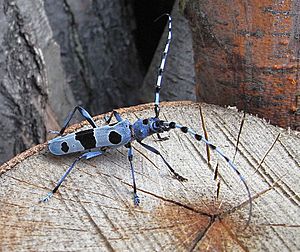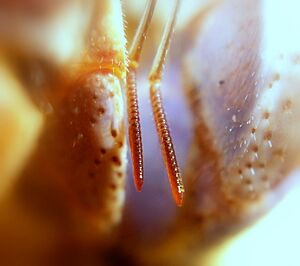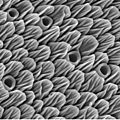Antenna (biology) facts for kids
Antennae (say: an-TEN-ee) are like special feelers that insects and crustaceans have. They are usually found in pairs on the front of their heads. Think of them as tiny arms that help them explore the world!
These feelers are made of several parts joined together, and they stick out from the head. Antennae are super important sensory organs. They can help animals feel things, sense air moving, detect heat, pick up vibrations (like sounds), and most importantly, smell and even taste things.
Contents
Insect Antennae
Antennae are the main tools insects use for smelling. They are covered with many tiny sensors called sensilla. These feelers are paired, can move, and are made of different parts. You'll find them between an insect's eyes on its forehead.
Almost all insects have antennae, even if they are very small in young insects (larvae). Some other tiny creatures, like springtails and diplurans, also have antennae, but proturans do not.
How Insect Antennae Are Built
A typical insect antenna has three main parts:
- The scape is the base part, which connects to the insect's head.
- The pedicel is the stem-like part, right after the scape.
- The flagellum is the longest part, often made up of many smaller sections called flagellomeres.
Only the first two parts, the scape and pedicel, have muscles. This allows the insect to move its antennae in many directions. The number of flagellomeres can be very different from one insect to another. This can help scientists identify different insect species.
Sometimes, the end parts of the flagellum form a thicker shape, like a "club." This is common in many beetles and some wasps.
What Insect Antennae Do
Antennae are amazing! They have special sensors that can pick up tiny smell molecules in the air. These molecules include pheromones, which are chemical signals insects use to communicate.
When a smell molecule lands on an antenna, the sensors send a signal to the insect's brain. The brain then figures out what the smell is. Scientists can even measure the electrical signals from an antenna when it smells something using a special tool called an electroantennogram.
For example, Monarch butterflies use their antennae to help them find their way during their long migrations. Their antennae have a special "clock" that helps them use the sun to navigate correctly.
Crustacean Antennae
Crustaceans (like crabs, lobsters, and shrimp) have two pairs of antennae.
- The first pair is usually smaller and is often called antennules. These are simple, single-branched feelers.
- The second pair is often larger and has two branches coming from its base.
For most adult crustaceans, both pairs of antennae are used for sensing. However, young crustaceans (called nauplius larvae) use their antennae to help them swim!
In some crustaceans, like spiny lobsters, the second pair of antennae can be very long and noticeable. But in others, like crabs, the antennae are much smaller.
Images for kids
-
Electron micrograph of antenna surface detail of a wasp (Vespula vulgaris)
See also
 In Spanish: Antena (artrópodos) para niños
In Spanish: Antena (artrópodos) para niños







